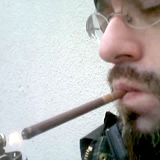This one time I was sitting around in the studio, talking to some old dude whose name you’ve probably have heard but who would really rather me not mention it here. Just like he would probably rather me not call him old, seeing as he’s not yet retirement age, but he’s a musical brother from a previous litter, and not enough people in music live to get old, so to me it’s a term of respect.
He heard about my incident with the bone flute and wrote me a letter congratulating me on re-deriving the pipe organ, but, you know, the soprano, hand-held model. He was genuinely impressed, but I thought he was yanking my chain, and I let him have it with both barrels, letting him know my flute had at lot more capacity for subtlety, for off-pitch discordant flavor, for organic pitch-bending. He agreed, apologized for giving me the wrong idea, and called me down for spending all my time on the internet where every comment was a jab from an ignoramus. He also asked if he could come by, because a face-to-face would minimize further misunderstanding. And then I recognized the code name he was using.
How the hell could I say no? He was world-famous for his work on synthesizers and constructed waveforms. His name came up a thousand times when I was working on my projects. Also I’d never heard anything but that he was a great guy.
We started off with the huge debate everybody has of analog versus digital. He was on both sides, which was a bit unfair, but then came down hard on the side of digital with the fact that the whole of creation is digital, thanks to quantum physics. He argued that you can use actual physical objects to produce any number that is the sum or the difference of any configuration of tiny, tiny numbers, but there are some that are just impossible to achieve. He went on to tell me that sound waves were also quantum phenomena, introducing me to the concept of the phonon (again, I thought he was yanking my chain until I looked it up) and that every lump of matter has an associated wavelength or frequency. I thought he was talking about resonant frequencies, but he said it went beyond that. Then I accused him of unmitigated New Age-ism, and he laughed and mentioned a name, and after he spelled it I went back to the internet and introduced myself to the works of a man named de Broglie.
Then we covered digital information transmission, carrier waves, modulation, bandwidth, and all that. How the shape of the ear gives us more location data than on which side of our head a noise is made, how we can tell if it was above us or below us or behind us, and how if you just attached huge rubber ears to studio microphones and turn them, you could save yourself tons of money on expensive electronics to get the same effects.
Okay, giant rubber ears are nothing but silliness, for all that they would actually work. And I knew some of that. But for all of the deadly serious physics crap flying around, I felt it was important to balance some of that out with the giant rubber ears.
But then we went back to the phonons and discussed how, given how electrical and magnetic superconductivity works, it should be possible to create pools of superconductive phonons in materials one hundred percent superconductive with respect to sound, or at least sounds of specific frequencies, and what kind of materials those could be, and whether you could make musical instruments out of those, and what would happen when you play them.
I could almost feel my skull cracking again. There’s how music affects the head and the heart — and then there’s how music affects the world. Literally, physically, affects the world. Like some kind of sorcery. It didn’t seem right that the world could be like this, but it is. Provably. Undeniably.
When the final trumpet blows to end the world, maybe there’s a quiet flute that will start it back up again.
[*]






